Mary Garden, Annapolis, Maryland
Mary Garden, Annapolis, Maryland
Mary Garden, Annapolis, Maryland
- Vincenzina Krymow
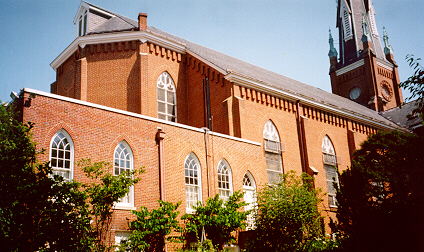
Dedicated on Mary's birthday, September 8, 1988, the Mary Garden in Annapolis, Maryland, is located behind St. Mary's Church, in the quadrangle formed by the church, the rectory and the historic John Carroll House. St. Mary's Church, on narrow Duke of Gloucester Street in the heart of old Annapolis, stands on the site of the first private Catholic chapel in Maryland, built in 1822 by Charles Carroll.
A Visit to the Garden
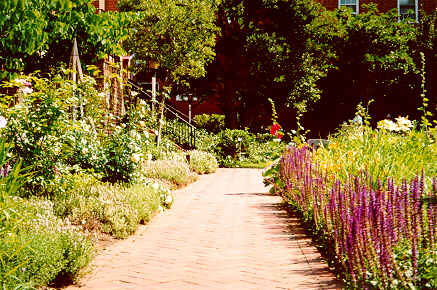
Red brick steps and a brick walk lead to the Mary Garden from the parking lot in the rear of the church. The walk, along the left side of the garden, leads to the Mary of Nazareth statue at the end of the garden.
The very old crepe myrtle tree, hundred-year-old boxwood circle and the surrounding red brick walls of the church, rectory and Carroll House all help to give this garden the appearance of being much older than it is. In front of the boxwood circle a wooden information box tells us of the plants growing here and their Mary names.
To the right, bright yellow Stella d'Oro day lilies remind us of St Joseph's faithfulness; behind them we see the Lord's Candle (yucca). Continuing to the right clusters of weeping lantana flowers call to mind the Sorrowful Face of Mary.
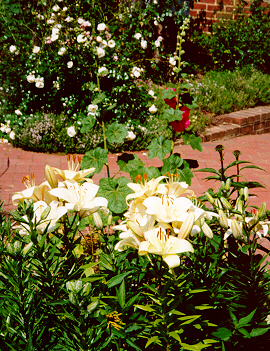
Next we see St. Joseph's staff (hollyhock), and more day lilies. Later in the season the Virgins flowers (zinnias) and Mary's Flower (shasta daisies) will bloom and Mary's Shawl (Russian sage) will blanket the area. We feel Mary's presence as we enjoy her flowers.
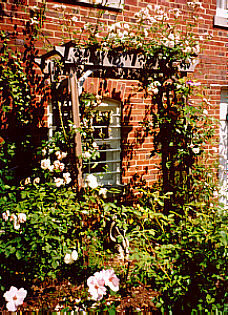
On our immediate left as we enter we see the Rosary, where a variety of rose bushes (Her Flower) have been planted. The Hail Marys of salvia echo our own. Climbing roses adorn an arbor in the middle of this space and manger bed straw (creeping thyme ) forms a border. We remember that roses, as well as lilies, grew in Mary's time and that roses have long been associated with Mary.
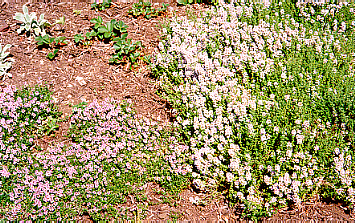
A walk leading to the church building separates the Rosary from the herb garden, which ends at another walkway, this one to the chapel where there is perpetual adoration. An angel watches over the Herb of Grace (rue) and other herbs, planted in a geometric design. We associate rue with regret, sorrow and pain and think of Mary's heartache and her anguish. Here we see manger bedstraw, Our Lady's Pincushion (sweet scabious), Our Lord's Back (yarrow) and stroke Our Lady's Fingers (lamb's ears).
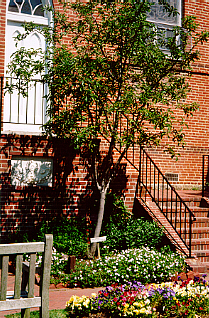
Beyond the path to the chapel, in an area called Mary's Garden, we sing Our Lady's Praises with the petunias as we contemplate Mary's apple tree (Lady Apple), the Gentle Virgin (pink geranium ) and Virgin's Bower (pink clematis). A recently installed marble fresco of two angels guarding the Eucharist looks down from the low brick wall to the left.
To the right tulips proclaim Mary's Prayers and pansies tell us of Our Lady's Delight. Here the Blue Lenten Flower (squill), Lenten Rose (helleborus) and a dogwood tree (The Cross) remind us of Mary's sorrow at the end of Jesus' life on earth. Along the edge we find the Crown of Thorns of barberry.
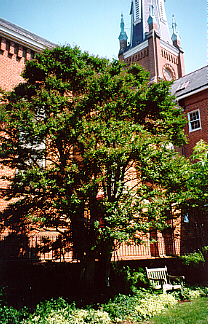
The garden opens up now into a wide grassy path leading to the statue of Mary and Jesus. In a large area on the left a very old crepe myrtle tree (her virginity) presides over Madonna lilies and Our Lady's Rose (peony). The Ave Maria sings out from beautiful hydrangea, some of it in a large pot. Lady fern, myrtle ground cover and Bishop's Weed ground cover (aegopodium) are luxurious here.
In this area, along a wrought iron railing, we see where god has walked (ground ivy) and remember the Holy Family's Flight into Egypt (lavender). We can reflect on Joseph, the faithful companion, with the day lilies and Maiden Grass (Japanese plume grass) and enjoy Our Lady's Frills (primrose).
Looking to the right we might meditate on Mary's Faith (veronica), the Trinity (Japanese iris) or Mary at the Cross (Cross wort, loosestrife). Phlox reminds us of Our Lady's Wedding, and we see the Virgin's glove (foxglove), Our Lady's Frills and Maiden Hair (sedum).
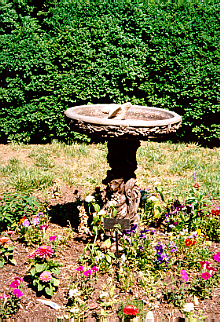
Further to the right, in the center of the garden, is a circle of one-hundred-year-old Candlemas greens (boxwood). Inside the circle school children plant their own garden each spring, each child naming her plant for her mother.
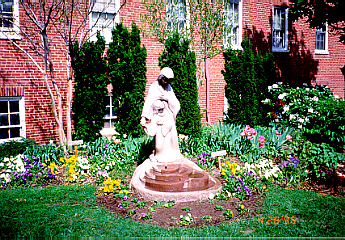
Straight ahead now is the four-foot Mary of Nazareth statue, sculpted from polished Vermont granite. Mary stands with one arm around Jesus, who looks up at her. Her expression is one of love and concern and she holds his hand protectively.
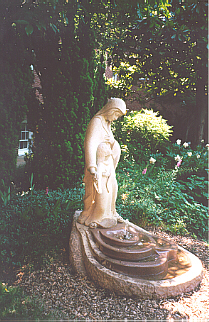
Three heart-shaped basins at the base of the statue form a circulating pool. We see Mary's Eyes (forget-me-not) in front of the statue and know that she loves us as she loved Jesus.
Two crepe myrtle trees (her virginity) and Mary's Berry tree (hawthorn) shade this area. The hawthorn tree was a gift of the parish kindergarten class of 1988. To the right of the statue Our Lady's Tears (lily of the valley) and Mary's Sword of Sorrow (iris) remind us of the sadness in Mary's life, while the Assumption Lily (hosta) and Heavenly Bamboo (nandina) tell us that Mary is in heaven. Seeing Our Lady's Roses (peonies), we share her joy.
On the rectory wall behind the fountain is a bronze plaque with names of those who contributed significantly to the garden. Nan Sears points out that her parents, who loved flowers and Mary, are listed first, while she and her husband are listed last. Among the names are those of Mary Garden advocates John Stokes, Bonnie Robertson and Edward McTeaghe, the latter two remembered with a gift from Stokes.
Moving to the right and along the right side of the garden, back towards the beginning, we find the Tree of the Cross ( yew), Silver Archangel (lamium) and Marys Star (daffodils). Now we come to the shade garden, a large area that brings us back to the front of the garden. Here we see where god has walked (ivy) under a linden tree. We find also Lady of the Snows (viburnum), Mary's Star and St. Joseph's Plant (azalea).
St. Justin the Martyr, who was beheaded sometime between 308-314 AD, is buried at the end of the garden. It is said that one of the Redemptorist fathers dug him up and brought him here in 1873 to save his remains from sacrilege or destruction. The bones were found in a church safe in 1987 and buried in the garden after the Vatican said "we have enough saints and his bones can stay there."
It should be noted that in this Mary Garden, not all of the plants are named after Mary but all have religious symbolism. A few of the plants were given Mary names by the garden's creators, consistent with the medieval practice of naming flowers.
Development of the Garden
A garden club lecturer from Virginia first told Nan Sears about Mary Gardens in 1945. Having grown up with a family who loved the woods and the wilds, Nan often thought of Mary when she was outdoors. "I feel she is there, a part of everything beautiful in the outdoors," she said. She decided she wanted a Mary Garden as a tribute to her and to be closer to her.
She immediately established a Mary Garden at home and always had one, wherever she lived, often improvising to create a shrine for Mary. One year she chiseled a hollow in the middle of a large lava rock left over from a garden show and pressed a plastic profile of the Madonna cradling the Infant Jesus into the recess. An annual 'soft paint' job disguises the plastic.
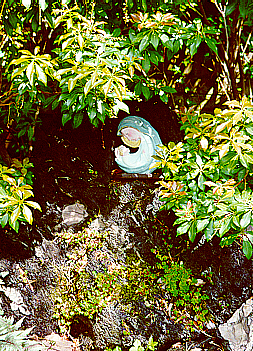
The rock was snuggled in Lady Fern and canopied with an overhang of Mary's Heart (bleeding heart). Our Lady's Delight (pansies) and Our Lady's Earrings (impatiens) were nestled in front of the rock, interspersed with the light blue of Mary's Wedding Dress (phlox). Nan carried the tiny grotto with her when she moved and it is now the focal point of the Mary Garden in her front yard in Annapolis.
It was not until she moved to Annapolis and became a member of St. Mary's Church that she found a pastor interested in a Mary Garden. In 1987 she received permission from Father John Murray, pastor of St. Mary's Church, to turn "a patch of weeds and gum wrappers behind the church" into a tribute to Mary. "Just don't ask me for any money," the pastor told her.
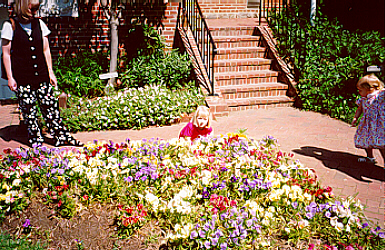
She knew Tony Dove, curator of the gardens at London Town Public House in nearby Edgewater, from her volunteer work there. With his help and that of another volunteer, Laura Van Geffen, she designed and laid out the garden. Dove, his wife and several of her brothers donated and brought in tons of dirt for the garden.
Nan looked for a sculptor and found him at the Paul VI Religious Art Center in Washington, D.C. A statue of Mary and Jesus was commissioned and she and Laura set out to raise thirty-five thousand dollars to pay for the garden. The need was announced from the pulpit and as the masses ended, eager young children with wreaths of flowers on their heads stood at the entrances with baskets in hand. Generous friends and parishioners gave money to pay for plants and the statue. Benches were donated as memorials and many of the permanent planting were given "in memory of ----."
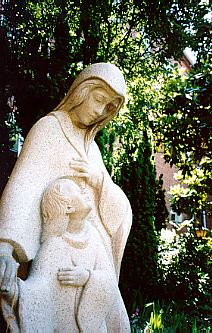
Leo Irrera's design for "Mary of Nazareth," showing Jesus when he was about nine or ten years of age, was sculpted from pink Vermont granite.
On September 8, 1988, the feast day of Mary's birth, Father Murray dedicated the garden. The statue was installed and blessed on Mary's birthday in 1991.
In 1994 the area inside the boxwood circle became a children's garden, designed and planted by fourth-graders. Children had been slipping into the boxwood circle and making it their own secret garden, so with the help of Kayla Lehmann, another Mary Garden volunteer, they made their own garden. A bird bath is in the center of the circle and a weeping angel (in sorrow over aborted babies) looks on. Child size benches encourage children to linger. The purpose of this garden is to encourage children to learn about Mary and honor her in their own way.
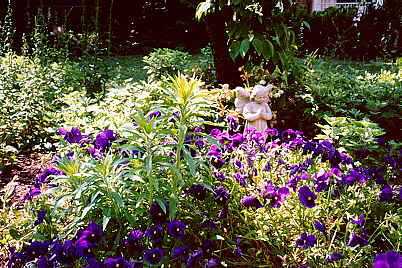
Volunteers from the parish tend the Mary Garden, which keeps changing as they replace those planting flowers that are not too successful, like the Stella d'Oro day lilies which replaced liriope. Nan Sears says she made up some of the Mary names, and figured it was OK since the medieval people had done the same thing.
Private Mary Gardens
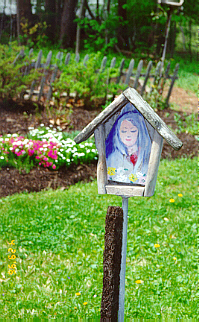
Nan Sears' Mary garden is in the front yard of her house. The lava rock which shelters Mary (a friend paints the plastic image for her every year), came from a garden show in Washington D.C. and is now in its third home--she moved it twice in Washington.
Ann Duffy, another Mary Garden volunteer, has her personal Mary Garden behind her house. It is a small area with blue flowers - a sea of blue, she said. Lady's Tears (blue spiderwort) surround the statue and Our Lady's Mantle (blue morning glories) envelopes the pole holding the image of Mary. The Hail Mary of vibrant blue salvia and the lavender of Flight Into Egypt are also there, with Virgin Pink (pinks) and Our Lady's Fingers (lamb's ears) for contrast. Ann painted the face of Mary on wood, copying it from a holy card, and it is sheltered in an altar-like wooden box.
Photos and text by Vincenzina Krymow. Information about this and other Mary Gardens can be found in Mary's Flowers: Legends, Gardens and Meditations written by Vincenzina Krymow published in 1999, by St. Anthony Messenger Press.
All About Mary includes a variety of content, much of which reflects the expertise, interpretations and opinions of the individual authors and not necessarily of the Marian Library or the University of Dayton. Please share feedback or suggestions with marianlibrary@udayton.edu.
